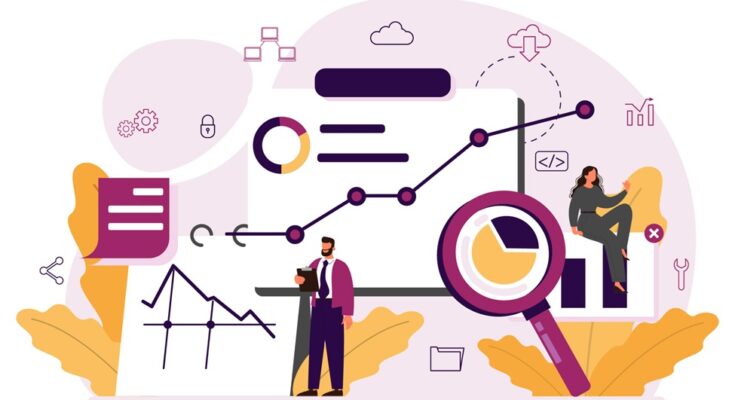Discover how data enrichment can lead to better marketing, how it differs from data cleansing, and the steps and tools you can use to enrich your data.
Enhanced data goes beyond raw information, offering extensive opportunities such as refining customer profiles, optimizing marketing tactics, increasing conversion rates, crafting personalized customer interactions, and more. A robust data enrichment process is essential for gathering, organizing, and leveraging data effectively to achieve these goals.
What Is Data Enrichment?
As a marketer, you understand that every action is driven by data. You gather data to develop buyer personas, tailor marketing materials to resonate with these personas, and distribute them via various channels like social media, continually collecting data to assess campaign performance.
The effectiveness of your marketing efforts directly correlates with the quality of your data. This is where data enrichment comes into play: it’s the process of enhancing and refining your customer data to ensure accuracy and reliability, thus providing a comprehensive view of your audience.
Data enrichment involves acquiring additional data to incorporate fresh insights from analytics or supplementary sources, and verifying existing data against third-party sources to maintain precision.
What Is the Use of Data Enrichment?
Data enrichment serves multiple specific purposes beyond broad improvements in marketing performance. Here are key ways to leverage data enrichment for enhancing your marketing efforts:
- Gain deeper insights into customer needs and expectations to deliver superior customer experiences.
- Refine data for creating precise customer segmentation models.
- Craft personalized and authentic marketing messages tailored to specific customer segments using enriched data.
- Identify the most effective marketing and sales channels for promoting and selling your products.
- Optimize marketing and sales expenditures by enhancing campaign accuracy and identifying efficient strategies.
- Improve lead generation and nurturing efforts through refined data analysis.
What Is the Difference Between Data Transformation and Data Enrichment?
As you delve deeper into data enrichment, you’ll encounter related terms that can be confusing, such as data transformation, also known as “data cleansing.” Let’s clarify the distinction between these concepts.
Data Transformation and Data Cleansing
As a marketer, you regularly accumulate extensive data to enhance your marketing campaigns. However, not all data is accurate or relevant to your objectives.
Data transformation, or data cleansing, focuses on refining the usefulness and accuracy of your existing data. This process aims to eliminate inaccuracies and irrelevant datasets to improve the quality of results produced.
Data Enrichment
In contrast to data transformation, which is subtractive, data enrichment is additive. Enriching data involves enhancing and expanding your existing datasets with new, supplementary information.
For instance, if your data indicates that college students are a primary target audience, data enrichment would involve delving deeper. You might seek to understand their academic pursuits—whether they are business or STEM majors, which colleges they attend, and whether they are pursuing undergraduate or graduate degrees.
Enrichment entails acquiring additional valuable insights that can further your marketing objectives.
What Are the Steps in Data Enrichment?
Now that we understand the uses and benefits of data enrichment, as well as its distinction from data transformation, let’s explore steps to enhance your data quality. These foundational steps can be tailored to fit the unique needs and datasets of your business, ensuring an effective enrichment process aligned with your workflows.
1. Define Your Goals for Data Enrichment
Before diving into data enrichment, it’s crucial to establish clear objectives tailored to your business needs. Define what you aim to achieve through the data enrichment process. For instance, if your goal is to enhance customer records or profiles, focus on enriching demographic data. Alternatively, if you seek to optimize marketing performance on specific social media platforms, enrich your data with relevant metrics for targeted consumer engagement.
2. Identify the Gaps in Your Data
Rather than gathering every possible data point indiscriminately, assess your current data against your established goals. Identify gaps and deficiencies in your existing dataset that hinder comprehensive insights. For example, a cosmetics retailer may find gaps in understanding which product categories appeal to different demographic segments—whether based on age, style preferences, or environmental consciousness. Closing these gaps enables more precise and effective targeted marketing efforts.
3. Create a Repeatable Data Enrichment Process
In marketing, adaptation to constant change is crucial. Develop a systematic and repeatable data enrichment process that can flexibly evolve with market dynamics. This process should be ongoing rather than a one-time effort, integrating workflows that are adaptable and scalable. Invest in reliable data enrichment tools and strategies that support continual data collection and validation.
4. Be Ready to Scale
As your business expands and your marketing efforts succeed, anticipate increased data volumes requiring enrichment. Ensure your chosen workflows and tools are capable of scaling to accommodate larger datasets without compromising accuracy or efficiency. Scalability is essential for sustaining growth and maintaining effective data management practices.
5. Collect Data, Apply It to Customer Segments, Then Rinse and Repeat
Execute your data collection processes and apply insights to refine customer segment profiles. Continuously iterate on your data enrichment efforts by identifying emerging gaps and adapting strategies accordingly. By establishing robust processes and leveraging comprehensive data, refine your understanding of customer needs and market dynamics over time.
What Data Enrichment Tools Should You Use?
So, how do you approach the collection and management of data to facilitate better, more informed decision-making? A variety of tools are available for this purpose. Let’s delve into a selection of them.
Jebbit
There are several platforms available that offer tools to assist marketers in directly collecting first-party data from their customers, with Jebbit being a standout choice. This platform enables the creation of quizzes, surveys, lead forms, and interactive experiences that engage customers while gathering valuable information for informed business decisions.
Jebbit’s “4 On Ramps” include a roadmap for a first-party data strategy, emphasizing data enrichment to develop comprehensive customer profiles. This approach enables the delivery of highly personalized content based on enriched customer insights.
Customer Data Platforms
Customer Data Platforms (CDPs) function akin to data warehouses, designed to facilitate the collection, management, and organization of customer data from diverse sources. These sources may include social media, CRM platforms, customer engagement tools, and more.
CDPs often incorporate automation to gather and organize real-time data efficiently. They also offer integrations with various software and systems used by marketing and sales teams, enhancing accessibility and usability of data across the organization.
Built-In Analytics
Marketing and sales software, along with social media platforms and CRM tools, typically provide built-in analytics capabilities. These tools automatically collect and analyze data related to customer relationships, geographic insights, demographics, income levels, and other critical details.
Leveraging built-in analytics allows businesses to derive actionable insights for optimizing targeted marketing strategies and enhancing customer engagement.
Third-Party Data Platforms
Third-party data platforms remain relevant despite evolving data privacy regulations. While their primary role has shifted due to increased scrutiny on data privacy, they still serve as valuable resources for validating internally collected data or filling minor gaps.
It’s crucial to vet third-party data platforms thoroughly for accuracy and compliance with CCPA and GDPR regulations before integrating them into your data strategy.
What Is a Data Enrichment Example?
Ready for some examples of data enrichment in action? Here’s a compelling case study showcasing a retail brand leveraging quizzes and rewards to engage customers and enhance data collection. This approach is crucial as industry shifts like changes by major tech players and data privacy regulations are phasing out reliance on third-party cookies.
By directly engaging customers through quizzes that explore lifestyle preferences and shopping habits, the brand incentivizes participation with rewards points. This strategy not only enriches their data but also provides valuable insights for decision-making. Additionally, quizzes have been instrumental in understanding customer pricing preferences and recommending suitable products.
The results have been significant, including a high lead capture rate through product match quizzes. This data enrichment process enables the brand to continually refine its messaging and content strategies, improving customer engagement and satisfaction.




